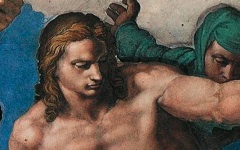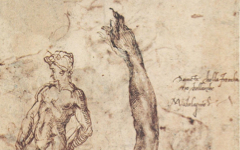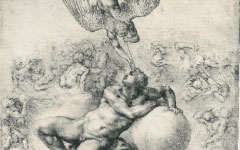Michelangelo’s Archers Shooting at a Herm (c.1530) Part 2

Michelangelo, Archers Shooting at a Herm (c.1530) Red chalk on paper. Royal Collection, Windsor Castle
Click image to enlarge.
In Part One I demonstrated how the adult figures in Michelangelo's Archers Shooting at a Herm are posed like sculptors aiming their arrows ("chisels") at the stone sculpture on the far right. Though there is valid doubt about whether the bust on the herm actually resembles Michelangelo, there can be no doubt that it represents him which is why an erect phallus drawn on the column symbolizes the fertility of his mind. That is not the only reference here to the mind of the visual poet.
Click next thumbnail to continue
Underneath in the left and right foreground three spiritelli (often called putti) are seemingly trampled by the archers yet remain unaware of the danger. One is asleep, the other two are kindling a fire. Scholars unanimously agree that, on account of these figures as well as the unexplained omission of bows and arrows, this drawing is of uncertain subject matter.
The small figures at left, though, are not cherubs or symbols of love as popularly believed but spirits inhabiting the body. Charles Dempsey recently corrected this long-held misconception without reference to this particular drawing.
Click next thumbnail to continue
Dempsey wrote: “As pneumatic substances, such spirits are not merely allegorical. They have real material and physiological existence….and in the medical and philosophical thought of the Middle Ages and the Renaissance they are conceived as active powers that are the source of all the body’s functions, transmitting nutriment, sensory data and even emotions in airy movement through the tubes of the arteries, veins and nerves.”1
Click next thumbnail to continue

Top: Diagram of Michelangelo's Archers Shooting at a Herm highlighting the artist's "eyes".
Bottom: A diagram to show how the archers are situated within Michelangelo's "head".
Click image to enlarge.
These spirits, then, are illustrations of the optic nerves shaped like "eyes" (top) which is why the archers float above them as an image of the creative struggle in the artist's mind. In his right "eye" two spirits blow the flames of his vision outwards and away from us while the other in his left "eye" dreams facing inwards. Together they are Michelangelo's inner and outer vision as seen from inside his mind. Meanwhile the herm, representing "his artwork", is where one would expect to find it, in the dead-center of his 3-dimensional brain-case as I have attempted to show in the right-hand diagram.
Click next thumbnail to continue

Top: Michelangelo, Archers Shooting at a Herm (c.1530)
Bottom: Michelangelo, The Creation of Adam (c.1511)
Click image to enlarge.
Just as God’s arm in the Creation of Adam is extended to simulate a painter’s (see Quick Guide to the Sistine Chapel), the extended arms of the archers simulate a sculptor’s. Remember pointing fingers or extended arms often draw, paint or sculpt. In fact, a scholar has already found a compositional similarity between the two images, though without finding meaning. “[Archers]", he wrote, "is almost a parody of God with his outstretched arm amidst his airborne entourage in the Creation of Adam.”2
See conclusion below
This new interpretation of the Archers provides additional support for the widely held belief that Michelangelo's David represents the sculptor: the archers and David are both nude with the same body type, both using "weapons" as artistic implements. David, in turn, supports our analysis of the Archers. The nudity, I should add, has little to do with Michelangelo's sexual preference: these figures are nude because souls and spirits, like those in the Last Judgment, were believed to be nude if they had a physical appearance at all – in both antiquity and the Renaissance.
Until now Michelangelo's Archers has made no sense because its elements neither contributed to a known narrative nor illustrated any known subject. Thus it is worth listing the features that until now scholars found inconsistent and/or inexplicable. Now, after this short analysis, they all seem apt.
* Nude figures in battle (mental conceptions of the artist's soul creating art)
* Archers holding no bows (a sculptor's archetto faces towards the artist, not away from him)
* The only bow faces the wrong direction (as above, the figure stringing his bow holds it in the direction of an archetto.)
* All but one archer is left-handed (in the "mirror" of the mind, the figures are mostly right-handed.)
* Stone is an inappropriate target for arrows (but as "chisels", they carve stone.)
* Phallic erection on the target’s plinth (artist's often use sexual symbolism for creative fertility.)
* A putto sleeps through a battle scene (instead the spirit of the artist's inward "eye" with a tail for the optic nerve.)
* Two groups of seemingly unrelated putti (they represent two separate and distinct "eyes".)
* The putti’s apparent lack of concern for their own safety (as "eyes" or "optic nerves" they are in no actual danger from the mental image above.)
As in my analysis of Edouard Manet's Le Déjeuner sur l'Herbe, Mlle V in the Costume of an Espada and many other paintings, once the scene is understood as taking place in the artist's mind all the previous "errors" and visual inconsistencies correct themselves.
For Part One of this analysis, click here.
More Works by Michelangelo
Michelangelo’s Last Judgment is a composition so full of incidents inconsistent with an orthdox reading of the Last Judgment and theology that experts often have trouble explaining them.

Michelangelo’s St. Sebastian in The Last Judgment
Notes:
1. Charles Dempsey, Inventing the Renaissance Putto (Chapel Hill: University of North Carolina Press) 2001, p. 43; Spiritelli are illustrations of natural forces sending messages from one part of the body to another. Dante describes them in La Vita Nuova, a book Michelangelo as an acknowledged scholar of Dante would have known well. Dante recounts how the natural forces of his body, personified as figural entities, converse with one another. Thus, on the first pages, describing the effect on his body of seeing Beatrice for the first time, he notes how: “..the vital spirit, which dwells in the inmost depths of the heart, began to tremble….As it trembled, it uttered these words: ‘Behold a god more powerful than I [ie. Love] comes to rule over me.’ “ The spirit of the senses which dwells in his brain then responds in amazement and says to the spirits in his eyes, ‘Now your source of joy has been revealed.’ In response “the natural spirit which dwells where our nourishment is digested” bemoans the fact that Dante’s appetite will be ruined.
2. James Hall, Michelangelo and the Reinvention of the Human Body (New York: Farrar, Straus & Giroux) , p.181. Interestingly Hall also links the herm to a drawing on human proportions by Dürer as well as dolls used by artists to study movement (pp. 183-4).
Original Publication Date on EPPH: 25 Feb 2012. | Updated: 0. © Simon Abrahams. Articles on this site are the copyright of Simon Abrahams. To use copyrighted material in print or other media for purposes beyond 'fair use', you must obtain permission from the copyright owner. Websites may link to this page without permission (please do) but may not reproduce the material on their own site without crediting Simon Abrahams and EPPH.




